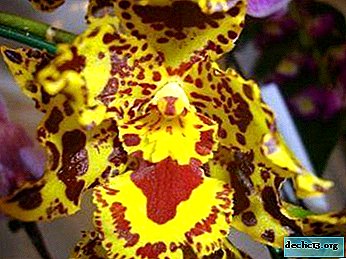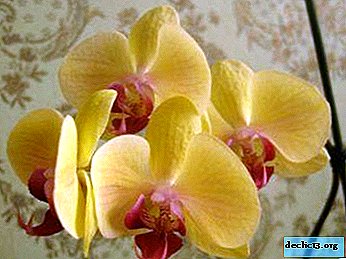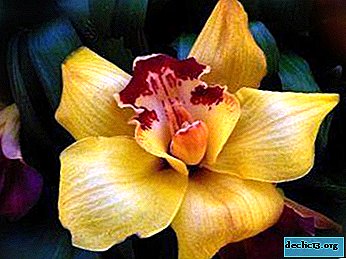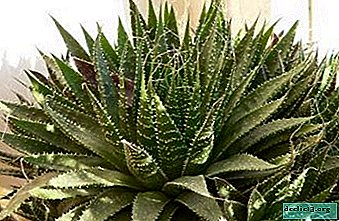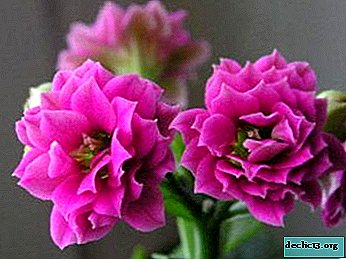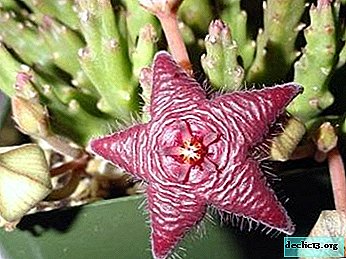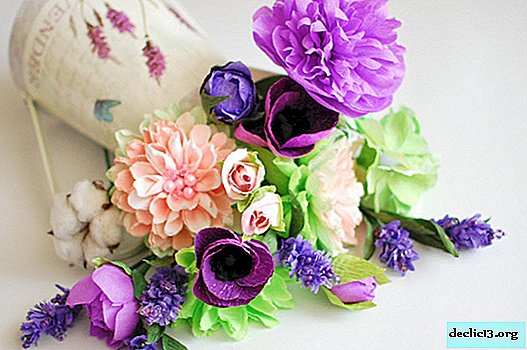The true queen of flowers is the Empress Farah rose. Description and photos of the plant, tips on reproduction and care
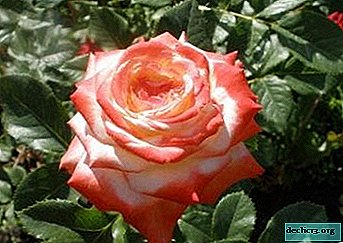
The beauty of the rose Empress Farah does not leave indifferent any grower. The variety attracts with its unique color and pleasant aroma.
Rose has numerous advantages and is not particularly difficult to care for. However, in order to admire the lush flowering bushes in your garden, you need to properly take care of the plantings.
In this article, you will learn how to properly care and propagate this beautiful plant. And also we will tell you what diseases and pests can attack the rose Empress Farah.
Detailed description
The variety belongs to the hybrid tea. Rosa Empress Farah is a perennial plant. The appearance of the rose corresponds to its magnificent name. Upright bushes have many shoots and are able to reach a height of one and a half meters. The leaves are large, shiny, light green in color.
On the shoot, usually one flower is located, less often brushes of several pieces are formed. The buds are large and goblet. Terry flowers, up to 15 cm in diameter, have a raised middle and are densely filled with petals. The color of the petals is double: in the middle - ivory, at the ends - scarlet or coral. The edges of the petals are twisted outward by triangles.
The aroma of roses is light, with hints of pear, a little perceptible, felt only at close range.
Plant pluses
- Unusual coloring.
- Suitable for landscaping, as well as for cutting.
- Cut flowers stand from 10 days to two weeks, while only the lower petals dry out, the shape remains.
- The flowering period lasts a long time.
- The decorativeness of the rose is maintained at any stage of flowering: both in the form of a bud and a fully blossomed flower.
- Tight petals.
- Rosa tolerates winds, rains, the sun and Russian winters.
- Safely leaves wintering.
- The variety is resistant to disease.
- Active growth begins in the second year.
Minuses
- The abundance of thorns complicates the care of the rose.
- It is difficult to give the bush the desired shape.
- Without trimming, few buds are formed.
- It requires regular top dressing, otherwise the quality of flowering is reduced.
- Very faint aroma.
Photo





History of occurrence
The variety was bred by breeder Henri Delbar in France in 1992. Rose was named after Empress Pahlavi Parach - the only crowned woman in the history of the Persian monarchy. The Empress did a lot for women and children of Iran and made a huge contribution to the cultural heritage of the country.
What is the difference from the rest of the species?
The variety is distinguished by an unusual color of flowers. Also, these roses come out of hibernation later than others, but quickly catch up and even surpass their neighbors in growth.
Bloom
When and how?
Blooms repeatedly and for a long time - from June to autumn frosts in two waves.
With appropriate care, up to 85 flowers bloom on an adult plant.Features of care before and after
- After spring pruning, ammonium nitrate is introduced in a ratio of 30 g per 1 sq. Km. m
- After 2 weeks, the procedure is repeated.
- At the beginning of budding, complex potassium fertilizer is used.
- Before flowering, fertilizing with a mullein solution is carried out - 1:10.
- After the first wave of flowering, the bushes are fed with full mineral fertilizer with microelements.
What to do if it does not bloom?
If the rose does not bloom, you need to determine the cause and amend the care scheme.
 The following factors may prevent flowering.:
The following factors may prevent flowering.:
- Nutrient deficiency.
- Excess nitrogen fertilizer. It is necessary to add ash or phosphorus-potassium fertilizer.
- Deficit of light.
- Errors during watering.
- Incorrect and untimely pruning.
- Diseases and pests.
Use in landscape design
Rosa Empress Farah is successfully used both in single plantings and in combination with other types of roses. It looks especially impressive surrounded by flat white flowers.
Step-by-step care instructions
The variety is not considered moody in care, but in order to maintain abundant flowering, it is necessary to create optimal conditions for the rose.
- Choosing a landing place. Ideally suited area well lit by the sun with sufficient air circulation, but protected from drafts. In the shade, rose petals turn pale and the splendor of flowering decreases. Groundwater should not lie too close to the roots of plants.
- What should be the soil? Rosa Empress Farah safely takes root on almost any ground. An excellent option is loamy, slightly acidic, moderately dry land. Excessively heavy or too light soils are not suitable.
- Seed planting. The method is unpredictable. When using it, plants that do not have the properties of a variety are obtained. If you want to experiment and grow completely new specimens, you can buy seeds or collect yourself from your own bushes.
- Temperature. Optimum summer temperature indicators are in the range from + 18 ° С to + 25 ° С. The maximum temperature is + 30 ° C, the minimum is -10 ° C. In the presence of a stable temperature within -10 ° C, the bush needs shelter.
- Watering. It is necessary to water the rose abundantly, avoiding the desiccation of the earthen coma. In the heat, more frequent watering is required, about 2 buckets of water at room temperature spend on one bush. After each watering, the soil is loosened.
Important! You can not overmoisten the soil, otherwise you can cause rotting of the root system.
- Top dressing. From the second year of life, feeding is carried out every two weeks. It is better to alternate complex mineral fertilizers and organics. The first top dressing is done after removing the winter shelter. During the formation of buds, potash fertilizers are used.
Mineral fertilizing is applied after watering.
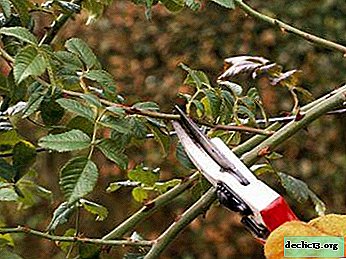 Pruning. In the spring carry out the main pruning. Damaged shoots are cut, strong and strong ones shorten up to 2-4 buds. In autumn, with a decrease in temperature to -10 ° C, the last flowers and weak stems are cut. Healthy shoots are cut in half, remove all leaves.
Pruning. In the spring carry out the main pruning. Damaged shoots are cut, strong and strong ones shorten up to 2-4 buds. In autumn, with a decrease in temperature to -10 ° C, the last flowers and weak stems are cut. Healthy shoots are cut in half, remove all leaves.- Transfer. Before transplanting, you must first prepare the site:
- They dig the earth. On 1 sq.m. Soils contribute 10-20 kg of compost or humus, 200 g of wood ash, 400 g of lime and 2 tbsp. l superphosphate.
- Dig a hole half a meter deep.
- Fertilized soil is placed at the bottom.
- The plant is removed from the ground, the root system is washed with water. If necessary, the bush is divided and each part is planted separately. After installing the plant in the pit, gradually sprinkle with soil, after which it is watered and spud.
- Preparation for winter. In mid-October and after the first snow, the plant is spudded. When the temperature drops to -10 ° C, pruning is performed and the root system is mulched. Then they cover the prepared bush with spruce branches.
Step-by-step instruction: how to propagate?
The rose Empress Farah is best propagated by cuttings.
- At the end of June, cuttings from shoots on which buds have not yet been opened are cut with a sharp knife. From the center of the stem, select areas with 2-3 buds, up to 8 cm long. The upper section is made even, the lower one is angled.
- The process is placed in boiled water, after adding a growth stimulator to it.
- A jar with a stalk is kept in the shade. After a day, change the water.
- Root buds appear after about two weeks. When the root system grows, the plant is transplanted into the garden. The seedling is covered with a jar and sprayed daily with water.
Diseases and Pests
The plant is resistant to powdery mildew, gray rot and black spotting.. Rose can get rust. In this case, the affected leaves are immediately removed. During the summer, the bushes are sprayed with 2% Bordeaux liquid or a copper-soap solution, a decoction of nettle or wormwood. The underside of the leaves is especially carefully treated.
Of the pests, the rose is most often attacked by aphids. The plant is sprayed with insecticides or folk remedies: a soap solution with the addition of a decoction of tobacco, ash and kerosene.
Roses Empress Farah - a chic decoration of a garden plot or park. Bushes do not require complicated maintenance, only numerous spikes can deliver minor difficulties. A bouquet of cut roses for a long time is able to maintain its decorative qualities.

 Pruning. In the spring carry out the main pruning. Damaged shoots are cut, strong and strong ones shorten up to 2-4 buds. In autumn, with a decrease in temperature to -10 ° C, the last flowers and weak stems are cut. Healthy shoots are cut in half, remove all leaves.
Pruning. In the spring carry out the main pruning. Damaged shoots are cut, strong and strong ones shorten up to 2-4 buds. In autumn, with a decrease in temperature to -10 ° C, the last flowers and weak stems are cut. Healthy shoots are cut in half, remove all leaves.